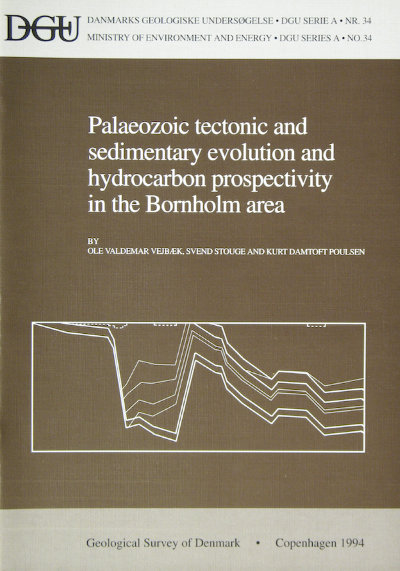Palaeozoic tectonic and sedimentary evolution and hyrdrocarbon prospectivity in the Bornholm area
DOI:
https://doi.org/10.34194/seriea.v34.7054Keywords:
Baltic Shield, Bornholm, Caledonian, Denmark, hydrocarbons, Paleozoic, Peribaltic Syneclise, Seismic stratigraphy, stratigraphy, TectonicsAbstract
The present distribution of Palaeozoic sediments in the Bornholm area is a consequence of several different tectonic regimes during the Phanerozoic eon. This development may be divided into three main evolutionary phases: A Caledonian to Variscian phase encompassing the Lower Palaeozoic sediments. The sediments are assumed originally to have showed a gradual thickness increase towards the Caledonian Deformation Front located to the south. This pre-rift development may be further subdivided into three sub-phases: A period of slow sedimentation on a relatively stable platform as recorded by the uniformly low thicknesses of the Cambrian to Lower Silurian sediments. A period of foreland-type rapid sedimentation commencing in the Llandoverian to Wenlockian, continuing in the Ludlovian and possibly into the Devonian. The period is characterized by /olding and uplift of the Caledonides to the south causing tectonic loading of the foreland and resultant rapid sedimentation in the foreland basin. A period of gravitational collapse causing minor erosion during the Devonian. The transition to the second major phase in the Phanerozaic structural development, during which the Sorgenfrei-Tornquist zone came into existence, is recorded by regional deposition of Carboniferous sediments. These sediments are, however, mostly removed by tater erosion. A syn-rift phase characterized by sedimentation in graben areas and expanding basins commencing in the Rotliegendes and continuing through the Triassic, Jurassic and Lower Cretaceous. This phase was probably initiated by a Late Carboniferous- Early Permian tensional dominated right-lateral wrench fault system within the Sorgenfrei-Tornquist zone. A Post-rift development phase dominated by Late Cretaceous carbonate sedimentation. During Late Cretaceous and Early Tertiary times the Bornholm area was strongly affected by inversion tectonism caused by compressional strike-slip movements. This resulted in reverse faulting and uplift and erosion of former basinal areas. Understanding the two latter phases is important for understanding the present distribution of the Palaeozoic. A key to understanding the hydrocarbon potential of the area is the maturation of the organic matter in the main potential source, the Ordovician Upper Alum Shale. Maturity was mainly achieved during the Silurian to Late Palaeozoic time, and little further maturation took place later. The Upper Alum Shale is accordingly expected to be overmature in the main part of the study area and mature in the Hano Bay Basin. This reflects the assumed primary uniform thickness of the Lower Palaeozoic, with a general thinning towards the northeast. A Caledonian to Variscian phase encompassing the Lower Palaeozoic sediments. The sediments are assumed originally to have showed a gradual thickness increase towards the Caledonian Deformation Front located to the south. This pre-rift development may be further subdivided into three sub-phases: A period of slow sedimentation on a relatively stable platform as recorded by the uniformly low thicknesses of the Cambrian to Lower Silurian sediments. A period of foreland-type rapid sedimentation commencing in the Llandoverian to Wenlockian, continuing in the Ludlovian and possibly into the Devonian. The period is characterized by /olding and uplift of the Caledonides to the south causing tectonic loading of the foreland and resultant rapid sedimentation in the foreland basin. A period of gravitational collapse causing minor erosion during the Devonian. The transition to the second major phase in the Phanerozaic structural development, during which the Sorgenfrei - Tornquist zane came into existence, is recorded by regional deposition of Carboniferous sediments. These sediments are, however, mostly removed by tater erosion. A syn-rift phase characterized by sedimentation in graben areas and expanding basins commencing in the Rotliegendes and continuing through the Triassic, Jurassic and Lower Cretaceous. This phase was probably initiated by a Late Carboniferous- Early Permian tensional dominated right-lateral wrench fault system within the Sorgenfrei-Tornquist zone. A Post-rift development phase dominated by Late Cretaceous carbonate sedimentation. During Late Cretaceous and Early Tertiary times the Bornholm area was strongly affected by inversion tectonism caused by compressional strike-slip movements. This resulted in reverse faulting and uplift and erosion of former basinal areas. Understanding the two latter phases is important for understanding the present distribution of the Palaeozoic. A key to understanding the hydrocarbon potential of thearea is the maturation of the organic matter in the main potential source, the Ordovician Upper Alum Shale. Maturity was mainly achieved during the Silurian to Late Palaeozoic time, and little further maturation took place later. The Upper Alum Shale is accordingly expected to be overmature in the main part of the study area and mature in the Hano Bay Basin. This reflects the assumed primary uniform thickness of the Lower Palaeozoic, with a general thinning towards the northeast.
Downloads
Published
Issue
Section
License
This article is distributed under a CC-BY 4.0 licence, permitting free redistribution and reproduction for any purpose, even commercial, provided proper citation of the original work. Author(s) retain copyright over the article contents.


